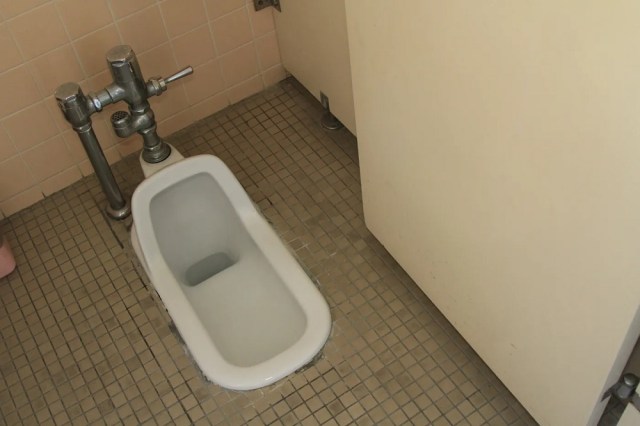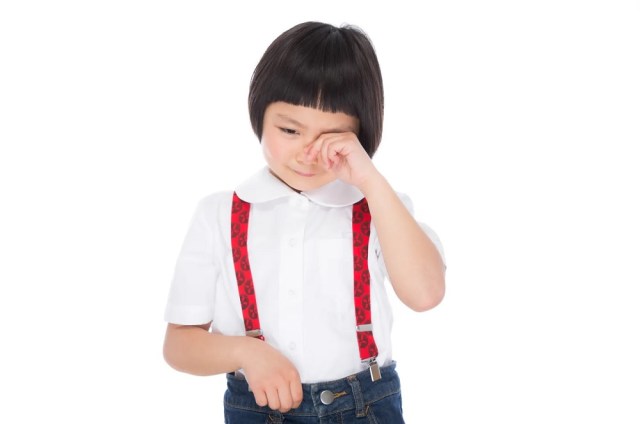
Girls seem to be much better than boys at using Japan’s traditional squat toilets.
Japan’s feature-rich toilets, with such luxurious comforts as heated seats and gentle sprays of butt-washing water, are a source of technological prestige for the nation. However, the Japanese phrase washiki toire, which translates to “Japanese-style toilet,” doesn’t describe those high-tech marvels, but rather a much simpler fixture that’s basically just a trough that you can flush set directly into the floor, as pictured above.
Japanese-style toilets used to be the norm in Japan, but they’re becoming less prevalent in modern society. There is, however, someplace where they’re still very common: Japanese schools. According to the Ministry of Education, Culture, Sports, Science and Technology, only 57 percent of elementary and middle schools in Japan had Western-style toilets as of 2020 (evidently when the most recent data on the subject was collected). That means that at roughly four out of ten schools kids need to use squat toilets, something that the Japan Toilet Labo research organization says is contributing to increasing rates of constipation among Japanese children.
In its annual defecation survey, which collected data from the parents of 1,000 elementary school-age kids, Japan Toilet Labo found that 20.1 percent of the children had constipation or pre-constipation symptoms, a higher number than in last year’s study. The organization asserts that sustained suppression of urges to go to the bathroom can cause constipation, and the survey showed that 81.8 percent of constipated children often or sometimes hold it if they’re at school, as opposed to just 38.4 percent of children without any constipation symptoms.
That would suggest it’d be beneficial to kids’ digestive health to make it easier for them to use their schools’ bathrooms. However, according to Japan Toilet Labo’s data, many children lack the balance and accuracy to drop a deuce cleanly into the trough of a Japanese-style toilet. The survey said that 26.7 percent of elementary school-age kids are unable to use one, with the data showing it’s an especially big problem for boys, perhaps because they can pee into a Japanese-style toilet without squatting or using a urinal, whereas girls’ lack of alternatives leads to more frequent squat toilet usage and greater proficiency through familiarity.
● Can’t use a Japanese-style toilet
Boys: 33.4 percent
Girls: 18.9 percent
● Can use a Japanese-style toilet but don’t like it
Boys: 47.1 percent
Girls: 55.3 percent
● Have no problem using a Japanese-style toilet
Boys: 19.5 percent
Girls: 25.8 percent
Despite those numbers, when the survey asked why kids were reluctant to use their schools’ bathrooms (and allowed multiple responses), only 9.1 percent said it was because of Japanese-style toilets, and Japan Toilet Labo urges schools to take steps to comprehensively increase the quality and atmosphere of their restroom facilities.
● Why don’t you want to use your school’s bathroom?
I don’t want my friends to know I’m defecating: 26.5 percent
I can’t relax: 22.2 percent
I don’t have enough time before I have to go back to class: 22 percent
My friends will laugh at me: 15 percent
The bathroom is dirty: 12.9 percent
The bathroom smells bad: 10.5 percent
It’s difficult to use a Japanese-style toilet: 9.1 percent
Still, roughly one out of 10 kids not wanting, or able, to deal with a squat toilet is an issue worth addressing. The Ministry of Education, Culture, Sports, Science and Technology says that around 90 percent of schools plan to add Western-style toilets, and even provides subsidies to help schools finance the changeover, and hopefully such initiatives and awareness will lead to students being able to look forward to things like playing with their friends or participating in extracurricular activities after school, as opposed to “It sure is gonna be great to finally poop once class is out.”
Source: Mainichi Shimbun via Yahoo! Japan News via Jin
Top image: Pakutaso
Insert images: Pakutaso
● Want to hear about SoraNews24’s latest articles as soon as they’re published? Follow us on Facebook and Twitter!


 Squat toilets’ popularity fading as parents call for them to be abolished in Japanese schools
Squat toilets’ popularity fading as parents call for them to be abolished in Japanese schools Do you really need to wear toilet slippers when using the bathroom at home? Japan’s netizens vote
Do you really need to wear toilet slippers when using the bathroom at home? Japan’s netizens vote Kyoto village dealing with poo on floor as Japanese-style toilets confuse foreign travelers
Kyoto village dealing with poo on floor as Japanese-style toilets confuse foreign travelers Japanese constipation survey reveals the most and least poop-frustrated prefectures
Japanese constipation survey reveals the most and least poop-frustrated prefectures Flush with New Year’s present cash, Japanese kids can now look forward to…saving it
Flush with New Year’s present cash, Japanese kids can now look forward to…saving it Foreigner’s request for help in Tokyo makes us sad for the state of society
Foreigner’s request for help in Tokyo makes us sad for the state of society Japanese city loses residents’ personal data, which was on paper being transported on a windy day
Japanese city loses residents’ personal data, which was on paper being transported on a windy day Should you add tartar sauce to Japanese curry rice? CoCo Ichi makes diners an unusual offer
Should you add tartar sauce to Japanese curry rice? CoCo Ichi makes diners an unusual offer Seaside scenery, history, and so many desserts on Yokohama’s Akai Kutsu【Japan Loop Buses】
Seaside scenery, history, and so many desserts on Yokohama’s Akai Kutsu【Japan Loop Buses】 Harajuku Station’s beautiful old wooden building is set to return, with a new complex around it
Harajuku Station’s beautiful old wooden building is set to return, with a new complex around it Japan’s summertime towelket pillowcases are even better with the addition of Ghibli stars【Photos】
Japan’s summertime towelket pillowcases are even better with the addition of Ghibli stars【Photos】 Akihabara pop-up shop sells goods made by Japanese prison inmates
Akihabara pop-up shop sells goods made by Japanese prison inmates The best Japanese cosplayers from Day 4 of Winter Comiket 2019【Photos】
The best Japanese cosplayers from Day 4 of Winter Comiket 2019【Photos】 Ghibli Park now selling “Grilled Frogs” from food cart in Valley of Witches
Ghibli Park now selling “Grilled Frogs” from food cart in Valley of Witches Sandwiches fit for a sumo served up in Osaka【Taste Test】
Sandwiches fit for a sumo served up in Osaka【Taste Test】 McDonald’s new Happy Meals offer up cute and practical Sanrio lifestyle goods
McDonald’s new Happy Meals offer up cute and practical Sanrio lifestyle goods Japanese ramen restaurants under pressure from new yen banknotes
Japanese ramen restaurants under pressure from new yen banknotes French Fries Bread in Tokyo’s Shibuya becomes a hit on social media
French Fries Bread in Tokyo’s Shibuya becomes a hit on social media Studio Ghibli releases new action figures featuring Nausicaä of the Valley of the Wind characters
Studio Ghibli releases new action figures featuring Nausicaä of the Valley of the Wind characters Red light district sushi restaurant in Tokyo shows us just how wrong we were about it
Red light district sushi restaurant in Tokyo shows us just how wrong we were about it New private rooms on Tokaido Shinkansen change the way we travel from Tokyo to Kyoto
New private rooms on Tokaido Shinkansen change the way we travel from Tokyo to Kyoto Tokyo Tsukiji fish market site to be redeveloped with 50,000-seat stadium, hotel, shopping center
Tokyo Tsukiji fish market site to be redeveloped with 50,000-seat stadium, hotel, shopping center Beautiful Ghibli sealing wax kits let you create accessories and elegant letter decorations【Pics】
Beautiful Ghibli sealing wax kits let you create accessories and elegant letter decorations【Pics】 Studio Ghibli releases Kiki’s Delivery Service chocolate cake pouches in Japan
Studio Ghibli releases Kiki’s Delivery Service chocolate cake pouches in Japan New definition of “Japanese whiskey” goes into effect to prevent fakes from fooling overseas buyers
New definition of “Japanese whiskey” goes into effect to prevent fakes from fooling overseas buyers Our Japanese reporter visits Costco in the U.S., finds super American and very Japanese things
Our Japanese reporter visits Costco in the U.S., finds super American and very Japanese things All-you-can-drink Starbucks and amazing views part of Tokyo’s new 170 meter-high sky lounge
All-you-can-drink Starbucks and amazing views part of Tokyo’s new 170 meter-high sky lounge More foreign tourists than ever before in history visited Japan last month
More foreign tourists than ever before in history visited Japan last month New Pokémon cakes let you eat your way through Pikachu and all the Eevee evolutions
New Pokémon cakes let you eat your way through Pikachu and all the Eevee evolutions Disney princesses get official manga makeovers for Manga Princess Cafe opening in Tokyo
Disney princesses get official manga makeovers for Manga Princess Cafe opening in Tokyo Sales of Japan’s most convenient train ticket/shopping payment cards suspended indefinitely
Sales of Japan’s most convenient train ticket/shopping payment cards suspended indefinitely Sold-out Studio Ghibli desktop humidifiers are back so Totoro can help you through the dry season
Sold-out Studio Ghibli desktop humidifiers are back so Totoro can help you through the dry season Japanese government to make first change to romanization spelling rules since the 1950s
Japanese government to make first change to romanization spelling rules since the 1950s Ghibli founders Toshio Suzuki and Hayao Miyazaki contribute to Japanese whisky Totoro label design
Ghibli founders Toshio Suzuki and Hayao Miyazaki contribute to Japanese whisky Totoro label design Doraemon found buried at sea as scene from 1993 anime becomes real life【Photos】
Doraemon found buried at sea as scene from 1993 anime becomes real life【Photos】 Tokyo’s most famous Starbucks is closed
Tokyo’s most famous Starbucks is closed One Piece characters’ nationalities revealed, but fans have mixed opinions
One Piece characters’ nationalities revealed, but fans have mixed opinions We asked a Uniqlo employee what four things we should buy and their suggestions didn’t disappoint
We asked a Uniqlo employee what four things we should buy and their suggestions didn’t disappoint Princesses, fruits, and blacksmiths: Study reveals the 30 most unusual family names in Japan
Princesses, fruits, and blacksmiths: Study reveals the 30 most unusual family names in Japan PooPaint Toilet paper lets you make art with your poop
PooPaint Toilet paper lets you make art with your poop Japan has established itself as King of the Thrones【Video】
Japan has established itself as King of the Thrones【Video】 Japanese students’ eyesight the worst in recent years, smartphones and mobile games are blamed
Japanese students’ eyesight the worst in recent years, smartphones and mobile games are blamed The top 10 instances when Japanese people feel thankful to be Japanese
The top 10 instances when Japanese people feel thankful to be Japanese Under 35 percent of middle school English teachers in Japan meet government proficiency benchmark
Under 35 percent of middle school English teachers in Japan meet government proficiency benchmark Animated toilet seats turn your bathroom into zen garden, bamboo forest, and more【Pics, Vids】
Animated toilet seats turn your bathroom into zen garden, bamboo forest, and more【Pics, Vids】 Japanese squat toilet plastic model kit: Weird, gross, or both?【Photos】
Japanese squat toilet plastic model kit: Weird, gross, or both?【Photos】 South Korean university develops toilet that converts poop to power and pays you for “deposits”
South Korean university develops toilet that converts poop to power and pays you for “deposits” 1 in 20 Japanese junior high school students regularly missing school, government study finds
1 in 20 Japanese junior high school students regularly missing school, government study finds Over half of Japanese students in nationwide test score zero percent in English speaking section
Over half of Japanese students in nationwide test score zero percent in English speaking section Japanese schools are losing their pools due to rising maintenance costs and aging facilities
Japanese schools are losing their pools due to rising maintenance costs and aging facilities Everything you think you know about your washlet toilet is wrong
Everything you think you know about your washlet toilet is wrong Nearly one in three Japanese men in survey prefer to sit down when taking a pee
Nearly one in three Japanese men in survey prefer to sit down when taking a pee What do toilets the world over look like? Check out this video to find out 【Video】
What do toilets the world over look like? Check out this video to find out 【Video】 Almost half of Japanese grade-school girls say they’ve never heard of “programming” in survey
Almost half of Japanese grade-school girls say they’ve never heard of “programming” in survey
Leave a Reply